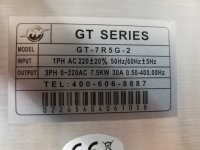I'm hooking up a VFD to power a Clausing 1500 lathe with a Doerr 7.5hp motor. I know this machine was powered by standard commercial 3 phase line when I tested it, although I don't know for sure if it was 240v or 480v, assumed 240v. There's no other electronics in the lathe except reversing switches.
I got my VFD and starting going through the numbers and found this 200v a little confusing. Any help deciphering what numbers I need to put into the VFD would be helpful.
It's a 10HP VFD. For reference I included the VFD tag as an additional picture. What kind of tolerance should a motor like this have, if the label was assumed to be right but in the past it was run on standard 208v, 220v or 240v 3 phase is it likely to be ok? Would it be OK to run it at 200v even if it's mislabeled?
Thanks,
-Bill Warner
I got my VFD and starting going through the numbers and found this 200v a little confusing. Any help deciphering what numbers I need to put into the VFD would be helpful.
It's a 10HP VFD. For reference I included the VFD tag as an additional picture. What kind of tolerance should a motor like this have, if the label was assumed to be right but in the past it was run on standard 208v, 220v or 240v 3 phase is it likely to be ok? Would it be OK to run it at 200v even if it's mislabeled?
Thanks,
-Bill Warner



